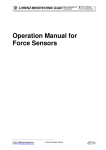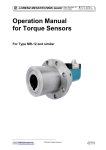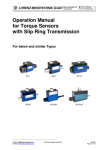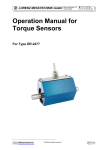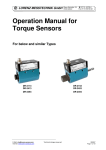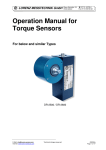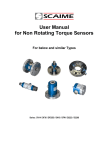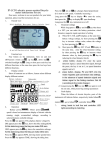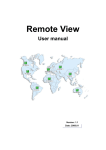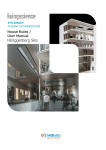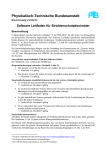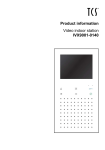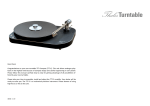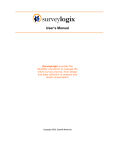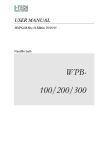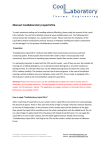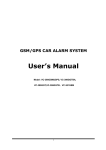Download Operation Manual for Torque Sensors
Transcript
LORENZ MESSTECHNIK GmbH Obere Schloßstr.131 73553 Alfdorf 07172 / 93730-0 Fax 07172 /93730-22 Operation Manual for Torque Sensors For below and similar Types DV-14 DFW-25 DH-15 DFW-35 D-2209 E-Mail: [email protected] Internet: www.lorenz-sensors.com D-2431 D-2223 DF-30 Technical changes reserved D-2268 D-2553 090138c.doc Page 1 of 11 LORENZ MESSTECHNIK GmbH Obere Schloßstr.131 73553 Alfdorf 07172 / 93730-0 Fax 07172 /93730-22 Imprint Manufacturer, Place Lorenz Messtechnik GmbH, D-73553 Alfdorf. Valid for... Static Torque Sensors Copyright © 2006 Lorenz Messtechnik GmbH, Alfdorf. Reprint Interdiction Reprints, even in extracts, only with written authority. Modification Technical changes reserved. References in this Text 1.6 Warning Notes; Page 4 Attention must be paid to the accident prevention regulations of the trade associations. During operation the safety precautions must be serviceable. 4 Mechanical Assembly; Page 6 Caution: During the assembly inadmissibly large forces may not act on the sensor or the couplings. At small torques (< 20 N·m) connect the sensor electrically during the assembly and observe the signal, the measurement signal may not exceed the limit values. During the assembly, the sensor must be supported to protect it from falling down. Caution at permutation of drive side and measuring side. 4.1 Sensors up to 15 N·m; Page 6 Sensors with nominal torques up to 15 N·m are very sensitive regarding overload; therefore treat the sensors with great caution. 6.1 Engaging; Page 8 The warming-up period of the torque sensor is approx. 5 min. 6.4.2 Natural Resonance; Page 9 Operation of the device in natural resonance can lead to permanent damages. E-Mail: [email protected] Internet: www.lorenz-sensors.com Technical changes reserved 090138c.doc Page 2 of 11 LORENZ MESSTECHNIK GmbH Obere Schloßstr.131 73553 Alfdorf 07172 / 93730-0 Fax 07172 /93730-22 Contents 1 Read First.............................................................................................................................................. 4 1.1 Safety and Caution Symbols.......................................................................................................... 4 1.2 Intended Use.................................................................................................................................. 4 1.3 Dangers.......................................................................................................................................... 4 1.3.1 Neglecting of Safety Notes ..................................................................................................... 4 1.3.2 Remaining Dangers ................................................................................................................ 4 1.4 Reconstructions and Modifications ................................................................................................ 4 1.5 Personnel ....................................................................................................................................... 4 1.6 Warning Notes ............................................................................................................................... 4 2 Term Definitions .................................................................................................................................... 5 2.1 Terms ............................................................................................................................................. 5 2.2 Definition of the Pictograms on the Torque Sensor ....................................................................... 5 3 Product Description ............................................................................................................................... 5 3.1 Mechanical Setup........................................................................................................................... 5 3.2 Electrical Setup .............................................................................................................................. 5 4 Mechanical Assembly............................................................................................................................ 6 4.1 Sensors up to 15 N·m .................................................................................................................... 6 4.2 Flange Connection ......................................................................................................................... 6 4.3 Shaft Connection............................................................................................................................ 6 4.4 Inside Square and Outside Square................................................................................................ 6 5 Electrical Connection............................................................................................................................. 7 5.1 Pin Connection............................................................................................................................... 7 5.2 Free Cable Ends ............................................................................................................................ 7 5.3 Cable.............................................................................................................................................. 7 5.4 Shielding Connection ..................................................................................................................... 7 5.5 Extension Cable ............................................................................................................................. 8 5.6 Running of Measuring Cables........................................................................................................ 8 6 Measuring.............................................................................................................................................. 8 6.1 Engaging ........................................................................................................................................ 8 6.2 Direction of Torque......................................................................................................................... 8 6.3 Static / Quasi-Static Torques ......................................................................................................... 8 6.4 Dynamic Torques ........................................................................................................................... 8 6.4.1 General ................................................................................................................................... 8 6.4.2 Natural Resonances ............................................................................................................... 9 6.5 Disturbance Variables.................................................................................................................... 9 6.6 Calibration Control (Option) .......................................................................................................... 9 7 Maintenance........................................................................................................................................ 10 7.1 Maintenance Schedule ................................................................................................................ 10 7.2 Trouble Shooting.......................................................................................................................... 10 8 Decommission..................................................................................................................................... 10 9 Transportation and Storage ................................................................................................................ 10 9.1 Transportation .............................................................................................................................. 10 9.2 Storage......................................................................................................................................... 11 10 Disposal ........................................................................................................................................... 11 11 Calibration........................................................................................................................................ 11 11.1 Proprietary Calibration.............................................................................................................. 11 11.2 DKD-Calibration........................................................................................................................ 11 11.3 Re-Calibration........................................................................................................................... 11 12 Data Sheet....................................................................................................................................... 11 13 Literature.......................................................................................................................................... 11 E-Mail: [email protected] Internet: www.lorenz-sensors.com Technical changes reserved 090138c.doc Page 3 of 11 LORENZ MESSTECHNIK GmbH 1 Read First 1.1 Safety and Caution Symbols Obere Schloßstr.131 73553 Alfdorf 07172 / 93730-0 Fax 07172 /93730-22 Caution: Injury Risk for Persons Damage of the Device is possible Note: Important points to be considered 1.2 Intended Use Torque sensors are intended for the measurement of torques. This measurand is further suitable for control tasks. The valid safety regulations should be absolutely respected. The torque sensors are not safety components in the sense of the intended use. The sensors need to be transported and stored appropriately. The assembly, commissioning and disassembling must take place professionally. 1.3 Dangers The torque sensor is fail-safe and corresponds to the state of technology. 1.3.1 Neglecting of Safety Notes At inappropriate use, remaining dangers can emerge (e.g. by untrained personnel). The operation manual must be read and understood by each person entrusted with the assembly, maintenance, repair, operation and disassembly of the torque sensor. 1.3.2 Remaining Dangers The plant designer, the supplier, as well as the operator must plan, realize and take responsibility for safety-related interests for the sensor. Remaining dangers must be minimized. Remaining dangers of the torque measurement technique must be pointed out. 1.4 Reconstructions and Modifications Each modification of the sensors without our written approval excludes liability on our part. 1.5 Personnel The installation, assembly, commissioning, operation and the disassembly must be carried out by qualified personnel only. The personnel must have the knowledge and make use of the legal regulations and safety instructions. 1.6 Warning Notes Attention must be paid to the accident prevention regulations of the trade associations. During operation the safety precautions must be serviceable. E-Mail: [email protected] Internet: www.lorenz-sensors.com Technical changes reserved 090138c.doc Page 4 of 11 LORENZ MESSTECHNIK GmbH 2 Term Definitions 2.1 Terms Obere Schloßstr.131 73553 Alfdorf 07172 / 93730-0 Fax 07172 /93730-22 Measuring Side: Shaft connection in which the torque to be measured is applied. Usually this side has the smallest moment of inertia. Drive Side: The shaft end on the opposite side of the measuring side with the larger moment of inertia. At static torque sensors the housing is fastened on this side. Low Torque Resistance Side: The shaft of the arrangement (drive, load) which can be turned considerably smaller with torque than the nominal torque of the torque sensor M << Mnenn . 2.2 Definition of the Pictograms on the Torque Sensor The measuring side of the torque sensor is designated as follows: Measuring side: M or M More information can be found on the data sheet if needed. 3 Product Description The sensor measures static and dynamic torques. The mounting position of the torque sensor is horizontally or vertically. Caution: it is to be differentiated between measuring side and drive side, see data sheet of the sensor: http://www.lorenz-sensors.com 3.1 Torsion Body Mechanical Setup The sensors do not contain rotary parts. They consist of a torsion body with different connection possibilities (flanges, shafts, square, hexagonal etc.). The torsion body, applied with strain gauges, is protected by a housing. A plug or a cable connection is fixed at the housing. Flange SG Supply + 3.2 Electrical Setup The strain gauge full bridge is directly connected at the plug or at the cable. R2 Optionally a calibration control can be integrated. For this, the SG full bridge gets detuned by an external switch in such a way, that at the output the measuring signal, which is corresponding to the positive nominal torque, can be measured. R3 external switch R1 Rk SG R4 Control Signal + Signal Supply - Sensor External Basic sketch of the strain gauge full bridge with option calibration control E-Mail: [email protected] Internet: www.lorenz-sensors.com Technical changes reserved 090138c.doc Page 5 of 11 LORENZ MESSTECHNIK GmbH 4 Obere Schloßstr.131 73553 Alfdorf 07172 / 93730-0 Fax 07172 /93730-22 Mechanical Assembly Caution: During the assembly inadmissibly large forces may not act on the sensor or the couplings. At small torques (< 20 N·m) connect the sensor electrically during the assembly and observe the signal, the measurement signal may not exceed the limit values During the assembly the sensor must be supported to protect it from falling down. It is to be differentiated between measuring side and drive side of the sensor. The housing is fixed at the drive side of the sensor. Caution at permutation of drive side and measuring side. • • The cable connection can influence the torque measurement. At dynamic measurements, the measured value can be influenced by the inert masses of the housing. Measuring side – see corresponding data sheet. 4.1 Sensors up to 15 N·m Sensors with nominal torques up to 15 N·m are very sensitive regarding overload; therefore treat the sensors with great caution. 1. Connect the sensor electrically during the assembly and watch the signal; the measuring signal may not exceed the limit values. 2. Align the arrangement before the parts are firmly connected. 3. Mount the sensor at the low torque resistance side first, then at the stationary side. (This avoids impermissibly large torques from acting on the sensor.) 4. Counter-hold by hand, so that impermissibly large torques or disturbance variables can not act on the torque sensor. 4.2 Flange Connection Before the assembly, flanges must be cleaned with dissolver (e.g. acetone), no foreign particles may adhere to them. The surface of the flange must indicate a evenness of at least 0.02 mm. Tighten screws consistently. The flange may not slip while torque is applied (surface pressure), if necessary use fitting bolts. 4.3 Shaft Connection The shafts must be cleaned with dissolver (e.g. acetone) before the assembly, no foreign particles may adhere to them. The hub must fit corresponding to the connection. 4.4 Inside Square and Outside Square The inside and outside square must be cleaned before the assembly. No foreign particles may adhere to them. E-Mail: [email protected] Internet: www.lorenz-sensors.com Technical changes reserved 090138c.doc Page 6 of 11 LORENZ MESSTECHNIK GmbH 5 Electrical Connection 5.1 Pin Connection 6-pin SG- excitation - 2 SG- excitation + 3 Shield 4 SG- signal + 5 SG- signal 100% calibration control 7-pin Function 1 SG- excitation - 2 SG- excitation + 3 Shield 4 SG- signal + 5 SG- signal 100% calibration control - 6 7 07172 / 93730-0 Fax 07172 /93730-22 Function 1 6 Obere Schloßstr.131 73553 Alfdorf View: socket on soldering side 5.2 5.3 Free Cable Ends Wire Function green Excitation (-) brown Excitation (+) yellow Signal (+) white Signal (-) grey Control netting Shield Cable Only use a shielded cable with preferably small capacity. We recommend measuring cables from our product range. They have been tested in combination with our sensors and meet the metrological requirements. 5.4 Shielding Connection In combination with the sensor and the external electronics, the shield forms a Faraday Cage. By this, electro-magnetic disturbances do not have any influence on the measurement signal. At potential difference problems we recommend to ground the sensor. E-Mail: [email protected] Internet: www.lorenz-sensors.com Technical changes reserved 090138c.doc Page 7 of 11 LORENZ MESSTECHNIK GmbH 5.5 Obere Schloßstr.131 73553 Alfdorf 07172 / 93730-0 Fax 07172 /93730-22 Extension Cable Caution: depending on bridge resistance and wire cross section, the measuring cable length enters into the characteristic value of the sensor. Therefore order the sensor together with the extension cable and the calibration at Lorenz Messtechnik GmbH. Dependence of the characteristic value on the cable length: Wire-cross section Cable resistance per m 0,28 Ω Deviation per m cable length at bridge resistance 350 Ω 0,08% Deviation per m cable length at bridge resistance 700 Ω 0,04% Deviation per m cable length at bridge resistance 1000 Ω 0,028% 0,14 mm² 0,25 mm² 0,16 Ω 0,046% 0,023% 0,016% 0,34 mm² 0,12 Ω 0,034% 0,017% 0,012% Cable resistance = 2 x resistance of the cable length (both feed lines of the sensor). The sensors with the ordered cable length are calibrated at Lorenz Messtechnik GmbH. Therefore the cable length does not need to be considered in this case. 5.6 Running of Measuring Cables Do not run measuring cables together with control or heavy-current cables. Always assure that a large distance is kept to engines, transformers and contactors, because their stray fields can lead to interferences of the measuring signals. If troubles occur through the measuring cable, we recommend to run the cable in a grounded steel conduit. 6 Measuring 6.1 Engaging The warming-up period of the torque sensor is approx. 5 min. Afterwards the measurement can be started. The warming-up period of the torque sensor is approx. 5 min. 6.2 Direction of Torque Torque means clockwise or clockwise torque if the torque acts clockwise when facing the shaft end. In this case a positive electrical signal is obtained at the output. Torque sensors by Lorenz Messtechnik GmbH can measure both, clockwise and counter-clockwise direction. 6.3 Static / Quasi-Static Torques Static and/or quasi-static torque is a slowly changing torque. The calibration of the sensors occurs statically on a calibration device. The applied torque may accept any value up to the nominal torque. 6.4 Dynamic Torques 6.4.1 General The static calibration procedure of torque sensors is also valid for dynamic applications. Note: The frequency of torques must be smaller than the natural frequency of the mechanical measurement setup. The band width must be limited to 70 % of the nominal torque. E-Mail: [email protected] Internet: www.lorenz-sensors.com Technical changes reserved 090138c.doc Page 8 of 11 LORENZ MESSTECHNIK GmbH Obere Schloßstr.131 73553 Alfdorf 07172 / 93730-0 Fax 07172 /93730-22 6.4.2 Natural Resonances c Estimate of the mechanical natural frequencies: ⎛1 1 1 ⎞ ⋅ c ⋅ ⎜⎜ + ⎟⎟ f0 = 2 ⋅π ⎝ J1 J 2 ⎠ f0 J1, J2 c = Natural frequency in Hz = Moment of inertia in kg*m² = Torsional rigidity in Nm/rad J2 J1 Further methods for the calculation of natural resonances are corresponding purchasable programs or books (e.g. Holzer-Procedure, Dubbel, Taschenbuch für den Maschinenbau, Springer Verlag) Operation of the device in natural resonance can lead to permanent damages. 6.5 Disturbance Variables By disturbances, measured value falsifications can occur by • Vibrations, • Temperature gradients in the torque sensor, • Temperature changes, • Electrical disturbances, • Magnetic disturbances, • EMC (electromagnetic disturbances), Therefore avoid these disturbance variables by decoupling of vibrations, covers, etc. 6.6 Calibration Control (Option) By a control resistance, a signal is generated in the sensor which corresponds to the nominal value of the sensor. Supply + R2 Rk SG Advantage: Re-Calibrations are reduced. Before each measurement the zero point and the nominal value can be checked. Function: By applying positive SG supply, the measuring bridge is electrically detuned, so that at the output a measuring signal of 100% of the nominal value is available. Optionally 50%, 80% possible. external switch R1 R3 R4 Control Signal + Signal Supply - Sensor External Use calibration control at unloaded torque sensor, only. E-Mail: [email protected] Internet: www.lorenz-sensors.com Technical changes reserved 090138c.doc Page 9 of 11 LORENZ MESSTECHNIK GmbH 7 Maintenance 7.1 Maintenance Schedule Action Control of cables and connectors Calibration Control of fixation (flanges, shafts) 7.2 Frequency 1x p.a. < 26 months 1x p.a. Obere Schloßstr.131 73553 Alfdorf Date 07172 / 93730-0 Fax 07172 /93730-22 Date Date Trouble Shooting This chart is used for searching for the most frequent errors and their elimination. Problem No signal Possible Cause No sensor excitation Signal output connected wrong Sensor does not react to torque Shaft not clamped • • • • • • • • • • • • • Outside of permissible range Connect supply Cable defect No mains supply Repair cable Connect correctly Repair cable Repair cable Mount correctly Release from distortion Reduce lateral forces Send to manufacturer Re-calibrate Sensor defect • Repair by manufacturer Torque shunt • Eliminate shunt No power supply Cable defect Connector connected wrong Signal has dropouts Cable defect Zero point outside of tolerance Cable defect Shaft mounted distorted Distorted shaft string Strong lateral forces Shaft overloaded Wrong torque indication Calibration not correct 8 Decommission • • • • 9 Trouble Shooting • Outside of permissible range • Connect excitation • Cable defect • No mains supply • Connect output correctly • Evaluation electronics defect • Clamp correctly All sensors must be dismantled professionally. Do not strike sensor housings with tools. Do not apply bending moments on the sensor, e.g. through levers. The torque sensor must be supported to avoid falling down during the dismantling. Transportation and Storage The transportation of the sensors must occur in suitable packing. For smaller sensors, stable cartons which are well padded are sufficient (e.g., air cushion film, epoxy crisps, paper shavings). The sensor should be tidily packed into film. Larger sensors should be packed in cases. 9.1 Transportation Only release well packed sensors for transportation. The sensor should not be able to move back and forth in the packing. The sensors must be protected from moisture. Only use suitable means of transportation. E-Mail: [email protected] Internet: www.lorenz-sensors.com Technical changes reserved 090138c.doc Page 10 of 11 LORENZ MESSTECHNIK GmbH 9.2 Obere Schloßstr.131 73553 Alfdorf 07172 / 93730-0 Fax 07172 /93730-22 Storage The storage of the sensors must occur in dry, dust-free rooms, only. Slightly lubricate shafts and flanges with oil before storing (rust). 10 Disposal The torque sensors must be disposed according to the valid provisions of law. For this, see our “General Terms and Conditions” www.lorenz-sensors.com 11 Calibration At the time of delivery, torque sensors have been adjusted and tested with traceable calibrated measuring equipment at factory side. Optionally, a calibration of the sensors can be carried out. 11.1 Proprietary Calibration Acquisition of measurement points and issuing of a calibration protocol Traceable calibrated measuring equipment is being used for the calibration. The sensor data are being checked during this calibration. 11.2 DKD-Calibration The calibration of the sensor is carried out according to the guidelines of the DKD. The surveillance of the calibrating-laboratory takes place by the DKD. At this calibration, the uncertainty of measurement of the torque measuring instrument is determined. Further information can be obtained from Lorenz Messtechnik GmbH. 11.3 Re-Calibration The recalibration of the torque sensor should be carried out after 26 months at the latest. Shorter intervals are appropriate: • Overload of the sensor • After repair • After inappropriate handling • Demand of high-quality standards • Special traceability requirements 12 Data Sheet See www.lorenz-sensors.com 13 Literature Dubbel, Taschenbuch für den Maschinenbau, Springer Verlag E-Mail: [email protected] Internet: www.lorenz-sensors.com Technical changes reserved 090138c.doc Page 11 of 11











